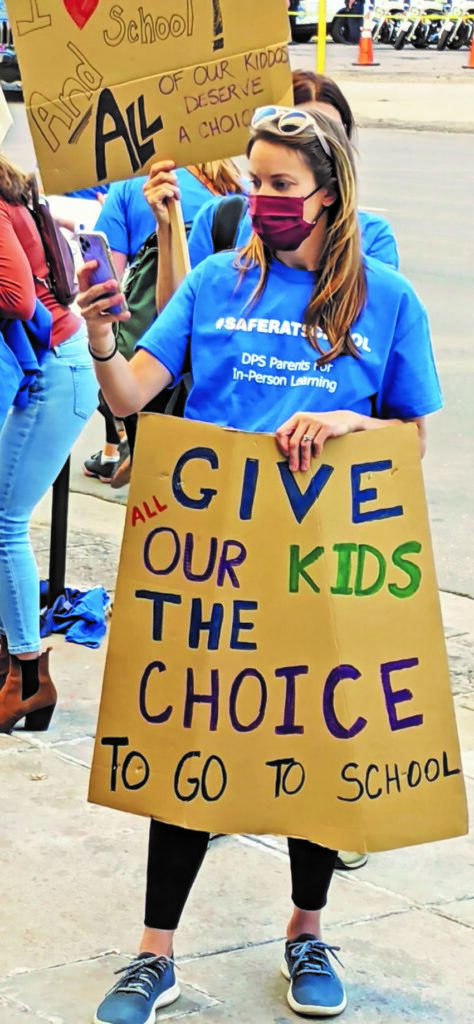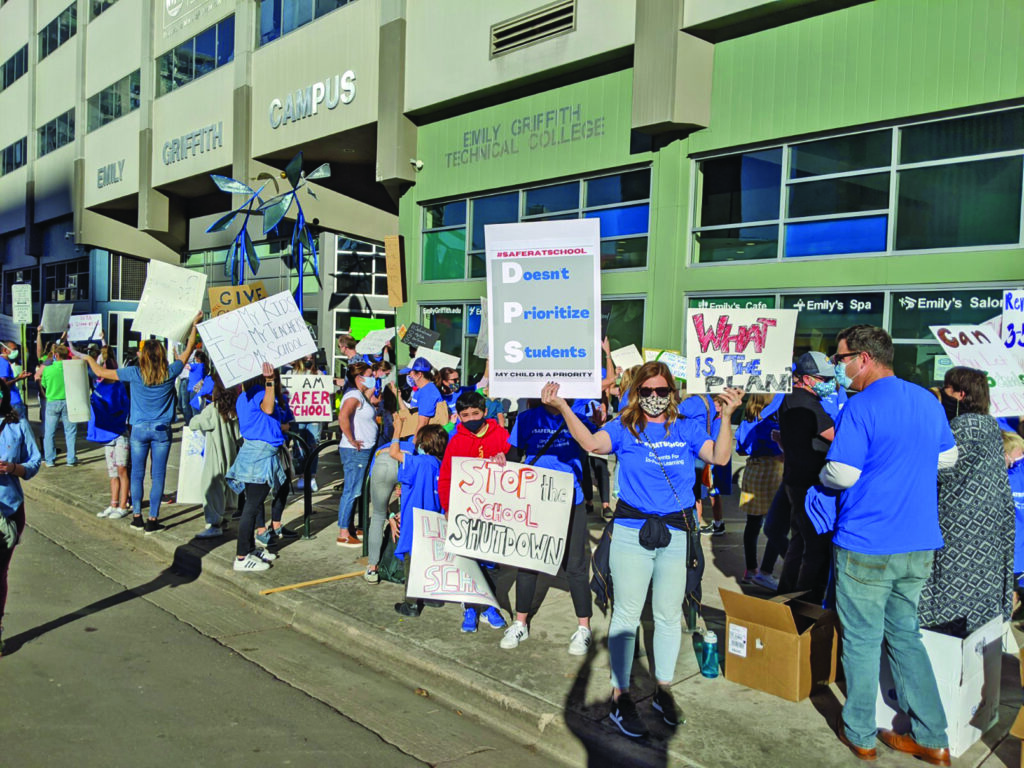Update: Since the time these interviews were conducted and the November edition of The Denver North Star went to print, COVID-19 numbers have continued to rise. More suburban school districts, including Cherry Creek and Littleton, announced that they will be moving to all remote learning, including for elementary school students. Other neighboring districts that previously offered in-person options earlier this school year are discussing switching to remote only. Westminster schools briefly considered a return to in-person learning but decided against the change. Most importantly, DPS Superintendent Susana Cordova has announced she will be leaving DPS for a new role in Texas. As DPS selects a interim and new superintendent, district policies may again change. We will continue to follow DPS in future issues.
Over 100 parents protested outside the Denver Public Schools administration building in favor of reopening schools. Nearly 1500 have signed an online petition for the same goal, and social media is abuzz with parents sharing stories of their challenges helping their elementary school-aged kids try remote learning while holding down their jobs. At the same time, school officials are concerned and frustrated with COVID transmission levels in the city and say that remote learning isn’t their ideal situation either. They’re worried about students being forced to bounce back and forth from in-person to remote disrupting education. Possibly the only thing that district leadership, school leaders, the teachers’ union, parents, and students can agree on is that no one is happy with the current situation.

While most DPS students have been remote all year, the district briefly returned 3rd-5th graders to the classroom, only to reverse the decision days later. DPS is the only district in the area that remained almost entirely remote, with most suburban districts offering some in-person options during the fall semester. In DPS, 2nd grade students and younger have continued to be in-person since the youngest students struggle the most with remote learning. Schools both in DPS and elsewhere that offer in-person learning send groups of students back home for remote learning when a student, faculty, or staff member they may have interacted with tests positive, usually from exposure believed to be outside of the school setting. In most cases, the return to remote learning is part of a 14 day quarantine. This has created a situation where students have been bouncing between in-person and remote learning. Some parents have been willing to accept the risk and pushed for older students to be allowed back in person as well, but DPS leadership believes that the frequent changes have been more disruptive to students and families than an all remote learning option. That concern both prompted the return of 3rd-5th graders to remote and has kept older students fully remote. “We’re not seeing big transmissions in our schools, but we are seeing the impact of frequent disruptions,” explained DPS Superintendent Susana Cordova.
“I don’t think there’s anyone at the district level who doesn’t want kids back in schools learning,” said Brad Laurvick, a director on the Denver Board of Education representing North Denver. “As a member of the team meeting regularly with doctors and teachers and principal leaders, I believe the shift for 3rd-5th graders was necessary to minimize disruptions in learning. I look forward to getting students back in-person as case loads decrease.”

DPS’ headquarters
Despite the possibility of students bouncing back and forth from schools to remote learning, some parents are advocating for schools to open, saying they are willing to take that risk, especially given that schools themselves have not been large COVID transmission sites and because suburban schools have been able to operate. Tina Leone lives in the Potter Highlands and her two kids attend Skinner Middle School. “I really commend Skinner on how they have engaged students,” explained Leone, who doesn’t fault individual school leadership for the situation. Instead, she’s frustrated with the Superintendent and district staff for what she says is a lack of engagement. “As a parent, I need transparency. I don’t feel DPS is providing that.” Leone doesn’t believe DPS has provided families with enough information and has made changes frequently with little notice, something that has made her role as a solo parent much harder.
DPS Board of Education director Tay Anderson, who serves at-large, was the only school board member to attend the parent protest, but he says he hasn’t made a decision about the district’s decision to return to nearly all remote learning. “I’m here because I want to listen to parents,” said Anderson. “This is not a one size fits all answer.”
The Denver Classroom Teachers Association, the union representing many DPS teachers, has been supportive of keeping more students remote and sent The Denver North Star a statement after the district’s decision to return to more remote:
“First of all, our thoughts are with all those affected by the COVID-19 pandemic. We, as a state, and here in Denver, are experiencing an increase in COVID-19 cases, which has necessitated communities across the state to place tighter restrictions on in-person gatherings to help prevent the further spread of this deadly disease. There is no place a teacher wants to be more than in their classrooms with their students. Students learn best and receive the best support in an in-person environment, but only when conditions are safe. We support the district’s decision to take swift and decisive action to keep students, educators and their families safe during this time of elevated concern.
We also support the state and city of Denver in taking aggressive action to help the spread of COVID-19. The sooner and more decisive the action, the sooner students and educators can get back to their classrooms. Our priority is the safety of every student, their family members and educators. We will continue to fight for the resources, protocols and community voices needed in making this a safe and productive learning environment for everyone involved.”
-Denver Classroom Teachers Association
Leaving DPS
Some parents aren’t waiting it out though. According to a spokesperson for Denver Public Schools, enrollment this year is approximately 1800 students fewer than they had projected. The largest discrepancy is in kindergarten enrollment. Berkeley resident and parent Jacinda Nettick Brown first started looking into learning pods, where a group of parents collectively hire a private teacher, but couldn’t find a good fit. “At that point we started researching private schools.” Nettick Brown pulled her two students, one in early childhood education and one in 1st grade, out of DPS after the proposed in-person start dates kept changing and approached flu season. While those students could currently be in-person at DPS, the frequent changes to DPS’ plan made her feel she couldn’t trust the district and she wanted the stability other options afforded her. She says some parents have been critical of her decision, but every family needs to make decisions for themselves. “It was put upon me to either give up my career or find a solution,” Nettick Brown said. “As a family, remote learning while trying to hold down a job…we were at a stress level of 9.”
She also isn’t sure if she’s going to return to DPS when they do eventually return to in-person learning. Back in August, when she and many other parents were looking into learning pods, the DPS board authored a letter encouraging parents not to pursue pods, linking the idea to Denver’s history of segregation. Nettick Brown said the letter was “tone deaf.” She and other parents found the letter offensive, especially what they saw as an insinuation that parents who opted out of DPS were racist and privileged. “Middle class doesn’t mean rich,” said Nettick Brown, adding that her family was making other financial sacrifices in order to pay private tuition.
During a briefing to the press and public in early November, The Denver North Star asked Superintendent Cordova about the families who chose to leave DPS. While her answer didn’t directly address the dip in enrollment, she used the opportunity to reiterate that DPS can’t reopen until Denver better addresses COVID numbers which have again been on the rise. “It’s important for all of Denver to embrace the responsibility we have.” She then discussed the importance of and how she frequently sees large groups gathering, a lack of mask use, and other behaviors that continue the spread of COVID-19, including in North Denver. Superintendent Cordova is a North Denver resident herself. She said she’s frustrated that too many people haven’t taken needed actions to lower the infection rate, which she believes needs to happen before schools can reopen fully.
A spokesperson for the district said they did not have demographic information on families who are leaving since many would be new this year, but will have more information as the school year progresses.
The Next Election
While the presidential election may be over, the next school board election is just under a year away and a few candidates have already announced. Several parents at the protest who were interviewed for this story believe the district’s decision will have a strong impact on the future balance of the board. Neither Laurvick or Anderson, both of whom were elected in 2019, will be on the ballot, but the other at-large seat and 3 district seats will be. For years DPS has been a battleground between education reform organizations, who advocate for more charter schools and generally oppose teachers’ collective bargaining rights, and DCTA, the union which advocates for teachers to have a great influence and generally aligns with more neighborhood schools. While the education reform-backed candidates held a majority on the board for over a decade, DCTA-backed candidates made large strides in 2019 and for the first time in recent history the majority of board members were backed by the union. Several parents at the protest held signs with slogans such as “Defund DCTA,” including some who said they supported teachers striking for better pay and conditions a year and a half ago but have since come to view the union more negatively.
While not all parents interviewed blamed the union for the district’s decision and several reiterated their support for teachers’ rights, some like Nettick Brown said while she supported the DCTA candidates in 2019, she won’t again. “The Teachers union is not acknowledging the harm being done,” said Nettick Brown. “Our policy makers have absolutely failed.” Superintendent Cordova said in a recent briefing that while DCTA is an involved partner their views were not the deciding factor, but parents like Nettick Brown see the new DCTA-backed board majority as the problem. Asked about supporting candidates backed by the union in the next election, she didn’t mince words. “I will never, ever do that again.”

Be the first to comment